Bluegill (Lepomis macrochirus), redear (L. microlophus) and green sunfish (L. cyanellus) are the most common of the 11 sunfish species. Sunfish are important forage fish throughout the United States. Since the 1930s sunfish, primarily bluegill, often have been stocked with largemouth bass (Micropterus salmoides) and are themselves popular sport fish.
Sunfish are extremely productive, with each female producing an average of 80,000 eggs per year from several successive spawns. This often results in overpopulation and stunted growth; most fish are less than 5 inches (12.7 cm) long. Producing hybrids is one strategy for controlling sunfish overpopulation. Various sunfish species interbreed readily, so hybrid production is relatively simple. Although hybrid sunfish are not sterile, some specific crosses result in skewed sex ratios (predominately males) and other crosses exhibit abnormal reproductive behavior; both conditions can reduce reproductive potential.
However, some sunfish crosses have hybrid vigor that is observed in improved growth rates, greater acceptance of formulated feeds, greater tolerance of cooler water temperatures and poor environmental conditions, and greater vulnerability to angling. Because of these particular characteristics, there is much interest in culturing hybrid sunfish commercially both for pond stocking and for food fish.
Spawning and reproductive activity
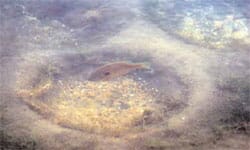 Figure 1. Sunfish are colonial nesters, constructing nests in densely packed clusters. After spawning the male sunfish defends the nest and cares for the eggs. Figure 1. Sunfish are colonial nesters, constructing nests in densely packed clusters. After spawning the male sunfish defends the nest and cares for the eggs. |
The sunfish family, Centrarchidae, is a strictly North American fish family. The native range of the bluegill was in the eastern U.S., while the green sunfish was found in the central U.S. and the redear sunfish in the southeastern U.S.
However, widespread introductions have increased the ranges of these sunfish throughout the country. The first researchers observed the basic biological activities of sunfish. These early studies found that all sunfish begin spawning in late spring or early summer and most continue spawning until early fall. Male sunfish usually appear first at the spawning sites. Males construct nests in shallow water by sweeping a depression in the sand or gravel. Sunfish are colonial nesters, with nests in densely packed clusters (Fig. 1). A male circles its nest and produces courtship calls consisting of a series of grunts. When a female is attracted to the nest, her eggs are deposited and then fertilized. One female may deposit eggs into several nests, and more than one female may deposit eggs into a single nest. After spawning, the female leaves the nest. The male remains to defend the nest from predators and fan the eggs to keep them aerated and clean of debris. Different sunfish species—i.e., bluegill and redear—are often found nesting together in the same colony.
Bluegill and green sunfish can spawn several times after water temperatures reach 70 ºF (21 ºC). The suitable temperature range for bluegill reproduction is 68 to 86 ºF (20 to 30 ºC), combined with a 12 to 16-hour photoperiod.
History of hybrid production
The earliest research on stocking hybrid sunfish for population control was conducted in the 1940s. Hybrids between female redear sunfish and male bluegill resulted in only 2 percent females, demonstrated good growth rates, and were considered excellent for stocking into small ponds. In the 1960s, all possible crosses between bluegill, redear sunfish and green sunfish were made. The resulting offspring showed different sex ratios. A cross with a female redear sunfish and male green sunfish produced offspring with a 50:50 sex ratio; however, all other crosses resulted in more than 70 percent males.
Broodstock: selection of species and sex identification
When producing hybrid sunfish it is critical to identify both the species and sex of the parent fish. Many taxonomic keys are available for species identification. Parent stock purity is important because offspring viability and performance will be affected. The sex of a selected parent species affects the F1 (first generation) offspring performance and sex ratios. For example, the most common hybrid parents are the green sunfish female and bluegill male; this cross produces F1 offspring with many desirWhen producing hybrid sunfish it is critical to identify both the species and sex of the parent fish. Many taxonomic keys are available for species identification. Parent stock purity is important because offspring viability and performance will be affected. The sex of a selected parent species affects the F1 (first generation) offspring performance and sex ratios. For example, the most common hybrid parents are the green sunfish female and bluegill male; this cross produces F1 offspring with many desirable characteristics (skewed sex ratio, rapid growth rate); however, the reverse cross does not.
Like most fish, sunfish are more easily sexed during the breeding season (Fig. 2). As spawning nears, males take on distinctive, brilliant, spawning colors and it is usually easy to express milt from the vent. During the breeding season, the abdomens of females are fuller and rounder than those of males. Males tend to be larger than females and have more square-shaped bodies.
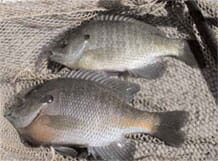 Figure 2. Sunfish are more easily sexed during the breeding season. The male bluegill (below) tends to be larger than the female (above) and takes on distinctive spawning colors. Figure 2. Sunfish are more easily sexed during the breeding season. The male bluegill (below) tends to be larger than the female (above) and takes on distinctive spawning colors. |
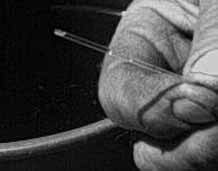 Figure 3. Inserting a capillary tube into the sunfish urogenital opening to retrieve eggs is the most reliable method for sexing adult fish. Figure 3. Inserting a capillary tube into the sunfish urogenital opening to retrieve eggs is the most reliable method for sexing adult fish. |
Although coloration and appearance are helpful in determining sex, gamete verification is usually necessary for a positive identification. First, use gentle pressure on the abdomen, moving from the middle of the abdomen back to the vent. If milt (white liquid) is expelled from the urogenital opening, the fish is a male. If no milt appears, the fish is probably a female but positive identification requires a capillary tube. A 0.04- to 0.05- inch-wide (1.1- to 1.2-mm) and 2- to 4-inch-long (5- to 10-cm) capillary tube should be used. Hold the fish upside down and gently insert the capillary tube through the urogenital opening (Fig. 3). Once the capillary tube is inserted into the urogenital sinus, angle it back toward the tail and slightly to one side. Then, gently push the tube through the oviduct and into the ovary. Use gentle force while slightly twirling the capillary tube back and forth. When the tube is inserted, place a finger over the end of the tube and remove it. If eggs are seen in the tube, the fish is a female. If no eggs are present and no milt was expelled, then sex cannot be determined and the fish should not be used.
Egg and fry production
There are two main methods of producing hybrid sunfish—stocking parent species into ponds for natural reproduction or artificial production through intensive hatchery methods.
Stocking parent species into empty ponds is currently the most common production method. Ponds less than 1 acre (0.4 ha) are preferred. To prevent contamination with undesirable sunfish, dry the spawning pond thoroughly and treat all depressions with approved fish toxicants before filling it and stocking with broodfish. Water from surface sources must be filtered using a Saran filter to prevent the introduction of undesirable fish. After the pond has been properly prepared, select mature male and female sunfish (preferably 2+ years old) and stock them into the pond. Stock 2-year-old parent fish at a 1:1 ratio of males to females at a rate of 30 to 40 pairs per acre (75 to 100 pairs/ha). Forty pairs per acre should yield approximately 100,000 fry per acre (247,000 fry/ha). Parents are allowed to spawn naturally in ponds and the young are raised in the same ponds as the adults until they are at least 2 inches (5 cm) long.
Even though most hybrids have been produced in ponds, intensive hatchery methods also have been successful. Eggs from one or more mature females of a selected species are stripped into damp glass Petri dishes. Then milt is stripped from one or more males of a selected species onto the eggs. Or, the testes from males can be excised and cut up, diluted with de-chlorinated water, and then added to the eggs. After mixing milt and eggs, water is added and the mixture is left for 2 minutes so fertilization can occur. Fertilized eggs are then transferred to clean glass Petri dishes containing dechlorinated water and allowed to become water hardened. Then the fertilized eggs are rinsed with water and the glass dishes are placed in aerated aquaria.
A second intensive hatchery practice involves manipulating temperature and photoperiod to induce spawning. Fish are held in tanks at a male-to-female ratio of 1:2 to 1:4. Removable artificial substrates are placed in the tanks for spawning (Fig. 4). The artificial nest pictured was made by removing the bottom 2 inches (5 cm) from a 5-gallon (19-L) plastic bucket and adding loose pea gravel to the bottom.
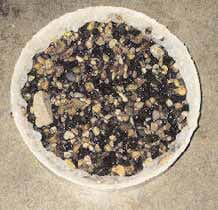 Figure 4. Removable artificial substrates can be used during induced spawning of sunfish. Figure 4. Removable artificial substrates can be used during induced spawning of sunfish. |
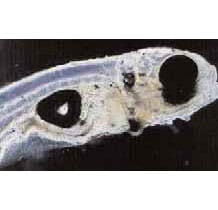 Figure 5. At the swim-up stage, larval sunfish must switch from obtaining food from their yolk sacs to obtaining food from the environment. Figure 5. At the swim-up stage, larval sunfish must switch from obtaining food from their yolk sacs to obtaining food from the environment. |
Begin with summer conditions (72 ºF [22 ºC] and16 hours of light) and gradually reduce temperature and photoperiod to simulate winter conditions (59 ºF [15 ºC] and 8 hours of light) over a 2-week period. Hold fish in winter conditions for 4 weeks and then gradually return them to summer conditions over an additional 2 weeks. Fish begin spawning on artificial substrates 2 to 6 weeks after the completion of the temperature and photoperiod manipulation. After spawning, remove the substrates with attached eggs for hatching and replace with fresh substrate. Using this method, eggs and fry can be produced at any time of year.
Eggs in substrate will hatch in 2 to 10 days, depending on the cross being produced and the temperature. Yolk sac absorption and subsequent swim-up stage (from 2 to 7 days post-hatch) also depend on the specific cross being produced and the temperature. Swim-up is the critical stage in sunfish development because larvae must switch from relying on their yolk sacs for nutrients and energy to obtaining food from the environment. During this stage, nutrients from the yolk sac are depleted and the larva’s mouth becomes more fully developed (Fig. 5). Larvae will starve if they do not begin to consume food at this time. The first prey items must be small enough to fit into the sunfish’s mouth (i.e., small zooplankton, including rotifers and copepod nauplii). Sunfish grow rapidly, and as mouth size increases, larger prey such as cladocerans, and eventually larger aquatic insects, are consumed. When reared in the hatchery, a commercial larval fish feed less than 250 μm should be fed at first, followed by progressively larger feeds as the sunfish grow. Hybrids (green sunfish female x bluegill male) will survive when fed commercial feed, but survival is greatly increased when newly hatched brine shrimp (Artemia) nauplii are fed during the first 7 days.
Grow out
Pond culture
The accepted marketable food size for sunfish is 8 to 12 ounces (227 to 340 g). Sunfish require at least 2 years to reach this size. Recommended stocking rates for hybrid sunfish grow out is 5,000 to 7,000 juvenile fish per acre (12,355 to 17,279 fish/ha) in year 2. Given the brood fish stocking rate of 40 pairs per acre (100 pairs/ha), it is anticipated that 100,000 fry per acre (247,000 fry/ha) will be produced in year 1. Fingerling sunfish should be stocked at 4 inches (10 cm) or larger and graded for size uniformity. Net production of 554 to 841 pounds per acre (622 to 942 kg/ha) can be expected when stocking hybrids at 3,238 to 5,666 fish per acre (8,000 to 14,000 fish/ha), with mean survival about 75 percent. In Kentucky, a net yield of 1,718 pounds per acre (1,926 kg/ha) was obtained by stocking 5,000 fish per acre (12,355 fish/ha) at an initial stocking size of 2.3 ounces (66 g). When water temperature reaches 72 ºF (25 ºC), fish should be fed a 35 percent protein diet at 3 percent of their body weight per day.
Cage culture
Cage culture of hybrid sunfish might be an attractive and viable option in areas where regular pond culture would not be practical. Irregularly shaped ponds, quarry pits or other bodies of water that cannot be seined easily are potential sites. Cage culture requires a relatively low initial investment and allows the simultaneous use of ponds for sport fishing or the culture of other species. There is no unwanted fish reproduction because sunfish cannot spawn in cages suspended in the water column. Therefore, fish size can be kept uniform and inventories are accurate.
Five hundred sunfish fingerlings can be stocked into a cage measuring 4 x 4 x 4 feet (1.2 x 1.2 x 1.2 m); 2,000 sunfish can be stocked into an 8- x 8- x 4-foot (2.4- x 2.4- x 1.2-m) cage. A more conservative guideline is to stock six fish per cubic foot (200 fish/m3). As observed in pond culture, best results are obtained when first-year stocking densities are reduced for the second year final grow out. As with pond-reared fishes, hybrid sunfish cultured in cages are fed a 35 percent protein diet with an anticipated mean feed conversion ratio of 3.54 and a specific growth rate of 1.03.
Recirculating systems
If sufficient land or water resources are not available, a recirculating system may serve for hybrid sunfish grow out. Recirculating systems usually use tanks for production so less land is required than in pond culture. Also, recirculating systems use much less water than ponds. However, recirculating systems have higher fixed costs (e.g., pumping costs and oxygenation) and require more intensive management and labor than pond culture.
Unlike pond production, a nutritionally complete diet is required to grow sunfish in recirculating systems. Hybrid sunfish in recirculating systems require dietary crude protein levels of more than 40 percent. Grow out stocking densities for sunfish in recirculating systems have not yet been determined. In an earlier NCRAC-funded project, stocking densities of 1.7 pounds per gpm (0.2 kg/Lpm) did not result in marketable fish within 30 months of stocking age-1 fish.
In Iowa, after 17 months in ponds and 12 months in an indoor system, hybrid sunfish had not reached marketable food size, even with repeated grading. This study indicated that there are still practical problems in the intensive culture of hybrid sunfish in recirculating systems.
Nutrition
Little is known of the nutritional requirements for specific life stages and species of sunfish. In ponds, producers often depend on natural food organisms (e.g., zooplankton and benthic organisms). However, with high fish densities these natural food sources can be depleted quickly. Therefore, producers should consider using supplemental diets to maintain high growth rates. Feeds that contain high levels of dietary protein (40 percent or more) and at least 10 percent dietary lipid (fish oil) improve the growth and production potential of hybrid sunfish. But when natural food is available, a dietary crude protein level of 36 percent is adequate to obtain maximum mean harvest weight. A mix of floating and sinking forms of pelleted feed 1⁄8 inch (3 mm) in diameter is recommended to balance the higher cost of floating feeds with the ability to observe feeding activity.
It has been shown that feeding frequency does affect the growth rates of juvenile hybrid sunfish. Increasing from one to three daily feedings increased food consumption and growth rates. The appetites of juvenile hybrid sunfish vary with the time of day, and daily appetite patterns change with feeding frequency. Three daily feedings produce the highest growth rates, but it is important to know how much to feed each time to avoid over- and underfeeding.
Environmental conditions for growth
Optimal temperatures for sunfish growth are 68 to 86 ºF (20 to 30 ºC). Most sunfish also spawn when temperatures are in this range. Sunfish growth generally increases as temperatures increase up to approximately 86 ºF (30 ºC), and then decrease at higher temperatures. The highest specific growth rate (SGR), 2.35 percent per day, was recorded at 86 ºF (30 ºC).
Temperature affects not only growth, but also survival. Bluegill eggs hatch at temperatures ranging from 73 to 93 ºF (23 to 34 ºC). The maximum hatch rate for bluegill eggs occurs at 72 to 75 ºF (22 to 24 ºC); this range is similar for hybrids. Fry have more thermal tolerance than eggs and juveniles have more thermal tolerance than fry.
There are no sunfish-specific guidelines for other water quality parameters. The broad guidelines recommended for other warm-water fish should be used. Alkalinity and hardness should range from 50 to 200 ppm as CaCO3 and pH should be 6 to 9. Carbon dioxide, un-ionized ammonia, nitrite and hydrogen sulfide should be kept at the lowest possible levels.
Disease
Although hybrid sunfish are considered hardy in the wild, they are susceptible to disease when grown at high densities. Bacterial, fungal and parasitic infections often plague cultured populations, regardless of culture method.
Columnaris is the most common bacterial infection in sunfish culture, but it seldom causes mortality. Infected fish should be removed rapidly and discarded to prevent horizontal transmission of the disease. Fungal infections can cause mortalities in cultured sunfish. Saprolegnia spp., the most common fungal infection, can be associated with dramatic temperature decreases. To avoid fungal infections, fish should be properly acclimated to the water temperature for best growth and temperatures should be kept constant. Digenetic trematodes such as black grubs (Uvulifer ambloplitis), white grubs (Posthodiplostomum minimum centrarchi), and yellow grubs (Clinostomum marginatum) are commonly found in sunfish. These grubs do not cause significant mortalities but do affect marketability. It is important to prevent infection because infected fish cannot be treated. To prevent grubs, limit bird access and reduce snail populations.
Harvest
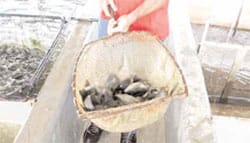 Figure 6. Harvesting hybrid sunfish from cages and recirculating systems is relatively easy. Figure 6. Harvesting hybrid sunfish from cages and recirculating systems is relatively easy. |
Most sunfish producers do not harvest fingerlings until the mean length of fish is 2 inches (50 mm), because smaller fish can be stressed by handling. Spring or fall is the recommended time for harvesting fingerlings and adult sunfish because water temperatures are lower then. Most producers use a non-tarred seine (square mesh 1⁄4 to 1⁄2 in, 6 to 12 mm) for pond harvest. Harvesting cages and recirculating systems is easier than harvesting ponds, but large harvests tend not to be as practical (Fig. 6).
Processing
There is no standard method for processing sunfish. Processing methods vary by location and social culture. After scaling, fish may be processed in-the-round (eviscerated or head removed and eviscerated) or filleted (skin on or skin off).
There also is no standard market weight for sunfish. The weight of a marketable food fish varies among locations and cultures; however, fish weighing more than 4 ounces (110 g) may be classified as marketable food fish. Considerable weight is lost from filleting as compared to in-the-round processing (58 vs. 32 percent, respectively); therefore, in-the-round cuts may be more profitable for producers with smaller fish from shorter grow-out periods. Sunfish may some day be available in live markets, considering the popularity of tilapia.
Regulations and permitting
Some states may classify sunfish as game fish and regulate their sale. Some states (Wisconsin, for example) have regulations against the stocking of hybrid sunfish in public waters. Given the diversity of state regulations, aquaculturists should consult with their state authorities to determine if there are regulations on rearing and selling sunfish.
The future
There is much interest in the intensive production and marketing of hybrid sunfish for food. However, sunfish culture on a commercial scale is a small industry at this time. The North Central Regional Aquaculture Center (NCRAC) surveyed state aquaculture contacts to determine the number of sunfish producers in each state, specific species produced, culture methods used, the most commonly used markets, and prices received. Nationally, there are about 485 sunfish producers with about onefourth of them producing hybrids (various crosses). Most commercial operations use pond culture and are located in Texas and Wisconsin. The primary markets for hybrid sunfish are for sport fish stocking and fee-fishing operations, though some states did report a market for food fish, bait and scientific research. The price per pound varies according to the source and the local markets, but producers could expect at least $1.00 per pound.
The most cost-effective strategies for fingerling production and grow out have not been determined. Out-of-season spawning techniques can use relatively small amounts of space with minimal investments, but pond culture is probably the most cost-effective method for grow out. Although hybrid sunfish have limited reproductive potential, some reproduction does occur in ponds. One way to control this limited reproduction might be to stock a small number of largemouth bass, channel catfish or other predatory fish during the second year of production, so that F2 generations are consumed.
The expansion of hybrid sunfish production is limited by the lack of proven, profitable and sustainable production technologies. Future research should address marketing, biological/technical knowledge (broodstock management, fry and fingerling propagation, grow out methods and processing procedures), and economics.
Suggested readings
Dupree, H. K. and J. V. Huner. 1984. Propagation of black bass, sunfishes, tilapias, eels, and hobby fishes. Pages 119-135 In Dupree, H. K. and J. V. Huner, editors. Third Report to the Fish Farmers. U.S. Fish and Wildlife Service, Washington, D.C.
Morris, J. E., C. C. Mischke and D. L. Garling. 2002. Sunfish culture guide. NCRAC culture series 102. North Central Regional Aquaculture Center Publications Office, Iowa State University, Ames, IA.
Morris, J. E., C. C. Mischke and R. L. Lane. 2005. Culture and propagation of sunfish and their hybrids. Pages 355-372 In Kelly, A. and J. Silverstein, editors. Aquaculture in the 21st Century. American Fisheries Society Symposium 46, Bethesda, MD.
May 2007


